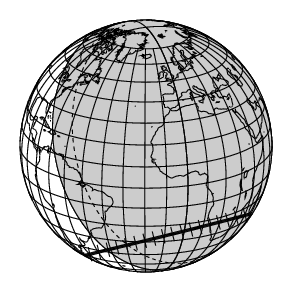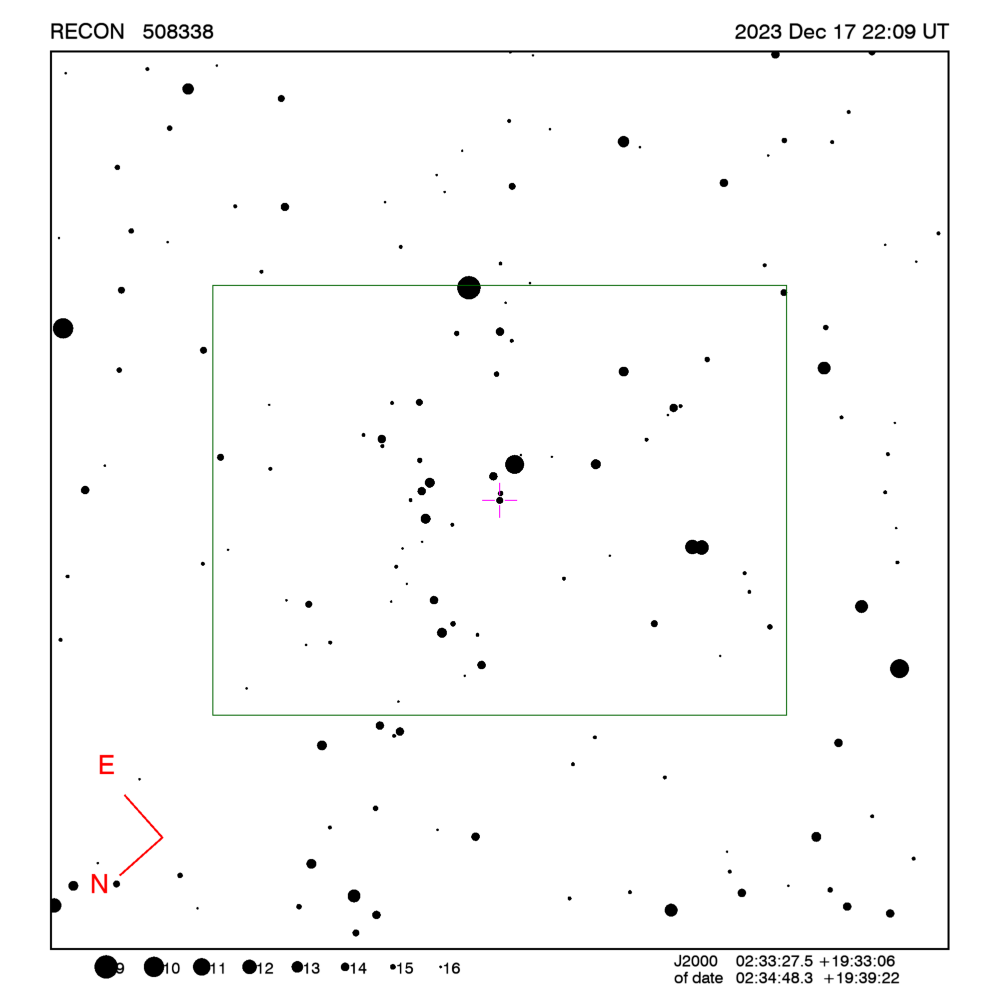RECON: TNO occultation with 508338
Event between (508338) 15SO20 and star GA1080:00264742
with event index number of 2245024
Geocentric closest approach at 2023/12/17 22:06:13 UTC
J2000 position of star is 02:33:27.5 +19:33:06
Equinox of date position of star is 02:34:47.9 +19:39:20
Stellar brightness G=15.7,
use SENSEUP=128 with the MallinCam and and exposure
time of 2 seconds with the QHY174 camera.
Star is 71 degrees from the moon.
Moon is 29% illuminated.
Apparent brightness V=22.0
 Object is 33.7 AU from the Sun
and 33.0 AU from the Earth.
Object is 33.7 AU from the Sun
and 33.0 AU from the Earth.
Apparent velocity is 15.7
km/sec on the sky relative to the star, or,
2.4 arcsec/hr.
The 1-sigma error in the time of the event is 98 seconds.
The 1-sigma cross-track error in the shadow position is
1539 km.
The object has an absolute magnitude Hv=6.6
Diameter=279.3 km assuming a 5% albedo -- 18.0 sec chord
Diameter=114.0 km assuming a 30% albedo -- 7.4 sec chord
Dynamical classification is CENTAURS
Star training set for 508338, (2023/12/17 22:09UT)
Object RA Dec mag sep mel
Aldebaran 04:37:17.9 +16:33:20 0.8 29.23 98
Hamal 02:08:31.8 +23:34:29 2.0 7.25 68
26 Ari 02:31:59.3 +19:57:38 6.1 0.73 71
PPM 118332 02:34:57.2 +18:59:04 7.1 0.67 71
PPM 118306 02:33:04.0 +19:23:44 8.8 0.49 71
PPM 118335 02:35:10.8 +19:35:51 10.2 0.11 71
508338 02:34:48.3 +19:39:22 15.7 72
Positions are for equinox of date

Azimuth is measured in degrees eastward from north.
North is at an azimuth of 0, due East is at an azimuth
of 90 degrees, due South is 180, and due West is 270.
Do not use the listing below for the RECON CPC 1100 telescopes.
This is provided for other non-team facilities.
Star training set for 508338, (2023/12/17 22:09UT)
Object RA Dec mag sep mel
Aldebaran 04:35:55.3 +16:30:29 0.8 29.23 98
Hamal 02:07:10.7 +23:27:41 2.0 7.25 68
26 Ari 02:30:38.5 +19:51:18 6.1 0.73 71
PPM 118332 02:33:36.7 +18:52:48 7.1 0.67 71
PPM 118306 02:31:43.4 +19:17:26 8.8 0.49 71
PPM 118335 02:33:50.0 +19:29:36 10.2 0.11 71
508338 02:33:27.5 +19:33:06 15.7 71
Positions are for J2000
Event circumstances last updated at 2023/11/06 05:16:47 UT
Marc W. Buie,
Southwest Research Institute
RECON
 Object is 33.7 AU from the Sun
and 33.0 AU from the Earth.
Object is 33.7 AU from the Sun
and 33.0 AU from the Earth.
